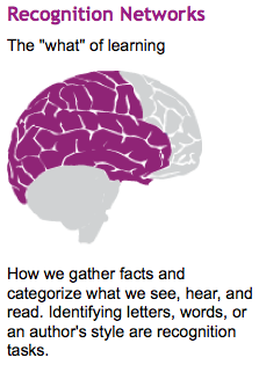The Recognition Network

Located in the back of the brain, recognition networks enable us to identify and interpret patterns of sound, light, taste, smell, and touch. These networks enable us to recognize voices, faces, letters, and words, as well as more complex patterns, such as an author’s style and nuance, and abstract concepts like justice.
Recognition networks are specialized networks to sense and assign meaning to patterns we see. They enable us to identify and understand information, ideas, and concepts.
Differences in the recognition networks of individual learners range from the subtle to the profound. For example, the “recognition cortex in Albert Einstein’s brain was disproportionately allocated to spatial cognition (Harvey, Kigar, & Witelson, 1999). He had difficulty recognizing the letter patterns and sound-to-symbol connections required for reading, but he was a genius at visualizing the deepest fundamentals of physics. Awareness of these differences across his recognition networks could have helped Einstein’s teachers shape instruction that would both capitalize on his spatial genius and support his areas of weakness.”
Source: http://www.cast.org/teachingeverystudent/ideas/tes/chapter2_3.cfm
Recognition networks are specialized networks to sense and assign meaning to patterns we see. They enable us to identify and understand information, ideas, and concepts.
Differences in the recognition networks of individual learners range from the subtle to the profound. For example, the “recognition cortex in Albert Einstein’s brain was disproportionately allocated to spatial cognition (Harvey, Kigar, & Witelson, 1999). He had difficulty recognizing the letter patterns and sound-to-symbol connections required for reading, but he was a genius at visualizing the deepest fundamentals of physics. Awareness of these differences across his recognition networks could have helped Einstein’s teachers shape instruction that would both capitalize on his spatial genius and support his areas of weakness.”
Source: http://www.cast.org/teachingeverystudent/ideas/tes/chapter2_3.cfm
Understanding the relationship between the UDL principles and the three primary neural networks
Download BrainNetworks_handout and use it to take notes as you learn about each of the brain networks.
OR
Go to this Google Doc: BrainNetworks
Select the following link to the CAST online module about recognition networks. Read about recognition networks then continue to the next page “Classroom Examples: Differences in Recognition” to review classroom applications of the recognition network.
Discussion Questions:
- What do recognition networks enable us to do?
- What is the affect of individual differences on recognition networks?
- What are the implications of this information for teaching and learning in your classroom?